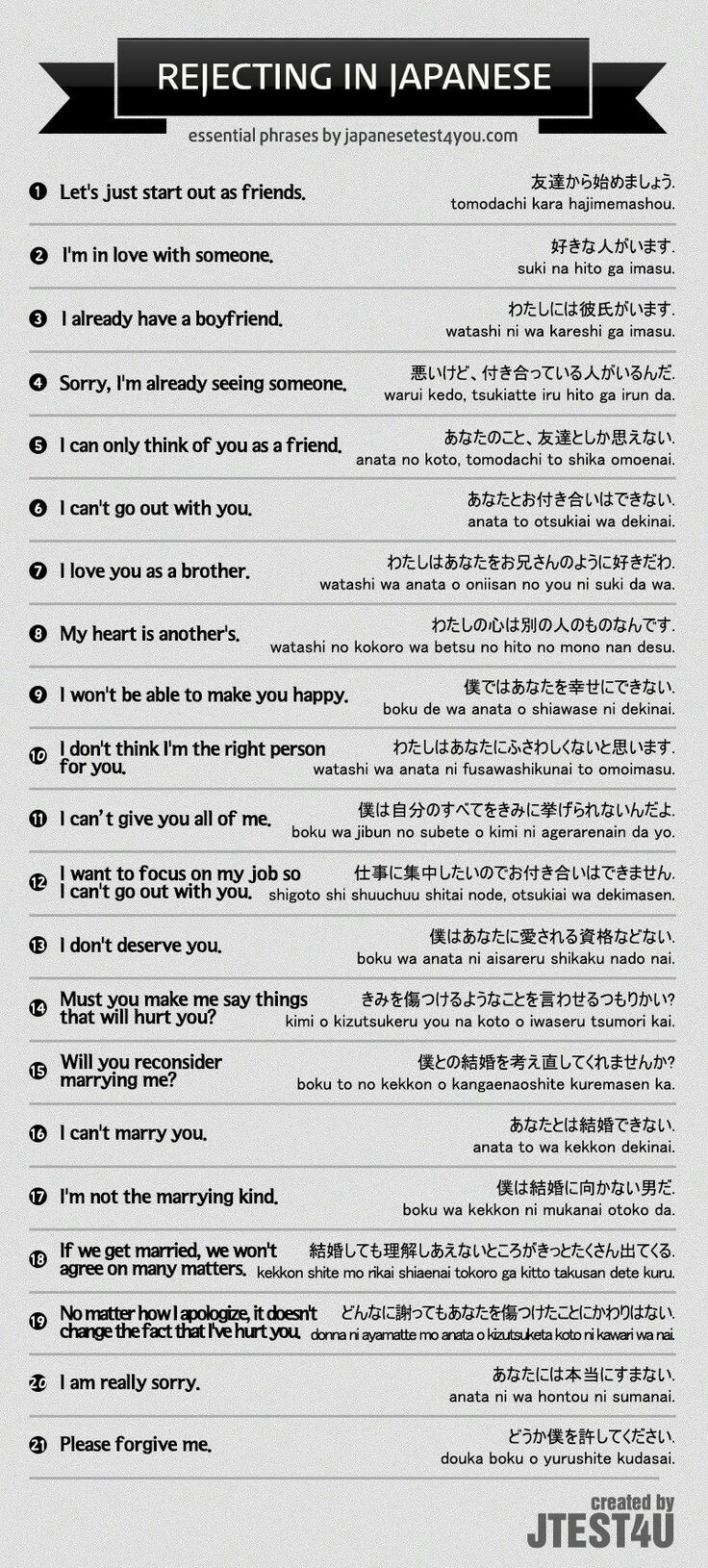Text
In Japanese, they don’t say “moon,” they say “tsuki,” which literally translates to “moon,” and I think that’s how language works.
488K notes
·
View notes
Photo
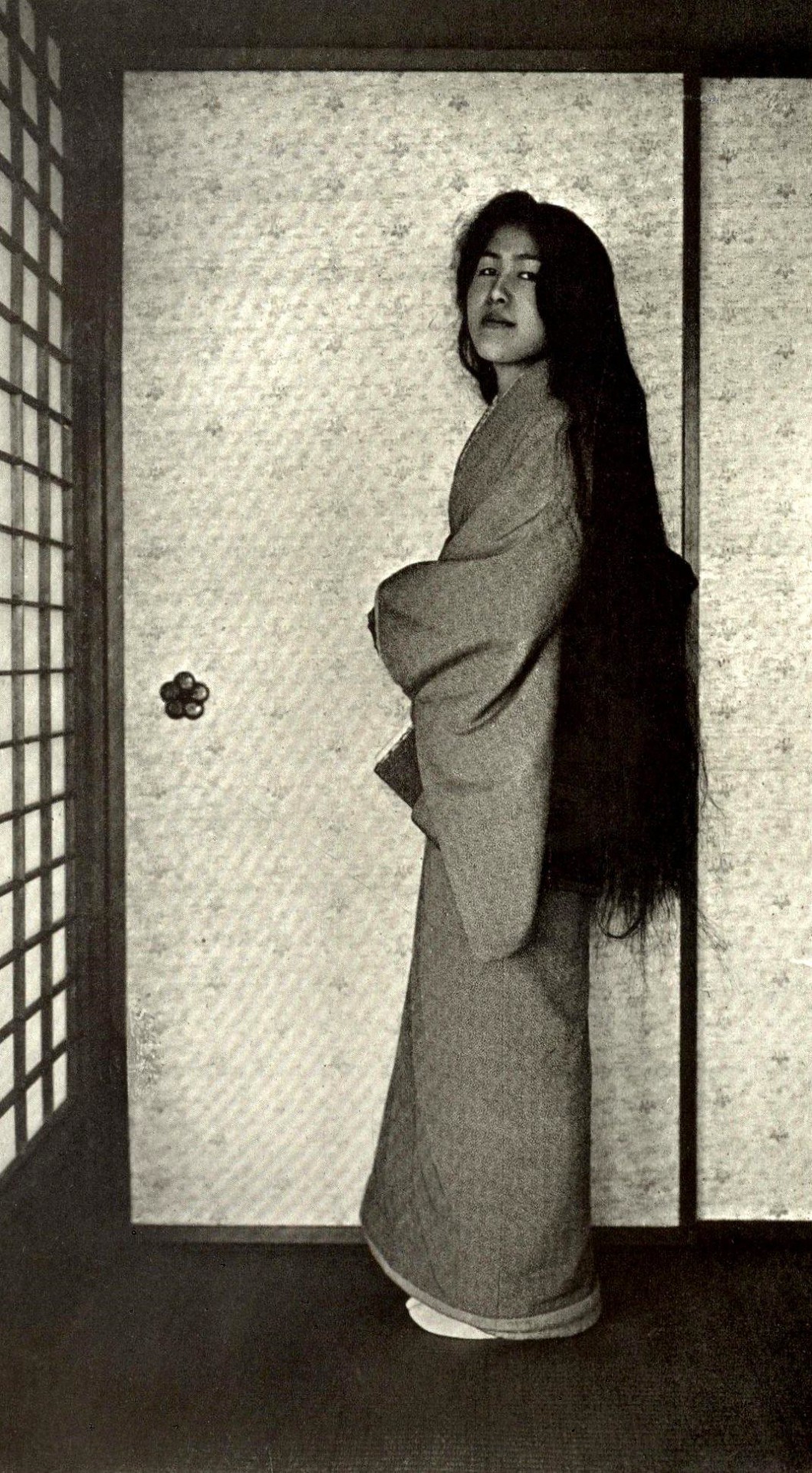
Herbert Ponting
(The real hair of a real geisha)
c. 1905
527 notes
·
View notes
Text
Really good anime translation: コタローは一人暮らし
I complained in a post a while ago about how I mostly think english translations of anime aren’t very good, and @japanwords asked me if there were any anime I know of that have good translations. I don’t actually watch that much anime so I didn’t have a good answer, but recently I found one that really fit the bill: 『コタローは一人暮らし』or “Kotaro lives alone”
For those who haven’t seen it, it’s a show about a 5 year old kid who lives alone without any parents or guardians, and makes friends with his neighbours in the apartment complex (a lazy manga artist, a woman who’s a hostess at a local nightclub, and a scary yakuza who finds Kotaro unbelievably cute). These friends end up helping Kotaro when he needs someone to act as a guardian, such as when he enrols at the local kindergarten.
The other thing you have to know about Kotaro is he speaks like a Japanese feudal lord.
This really is the crux of what makes the translation so good, because how the hell do you translate that?! The way they chose to do it is by using archaic english phrases. He kinda speaks like a Victorian era gentleman, and he sometimes even verges on sounding like a stereotypical medieval knight. This works perfectly, because Kotaro is actually imitating a character from his favourite cartoon: a samurai hero/feudal lord. Let’s look at some examples:
「放すである」
"Unhand me!"
A simple example to start with, I thought it might be interesting to compare how a 5 year old might actually say this, and how I would translate that:
「放してー!😭"」
"Let goooo! 😭"
Even though the japanese uses the same verb (放す), the english translation is completely different. The choice here to make it “unhand me” (much more evocative of a time period) instead of just “let go of me” (simply a longer way of saying it) is a perfect example of the care this anime puts into its translation.
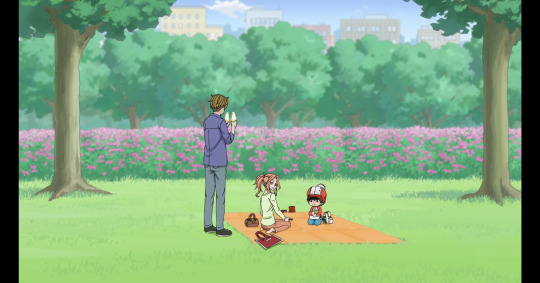
狩野:「美月さん、アイス食べます?…… あれ?」
“Hey, Mizuki. Would you like an ice cream cone? …… Hello?”
美月:「アイスをもらうけど私、狩野くん誘ってないんだよなぁ」
“While I appreciate the ice cream, you know you weren’t actually invited, Karino.”
コタロー:「お邪魔である」
“Interloper.”
邪魔 is a notoriously difficult word to translate, and the natural-sounding corresponding english phrase will vary quite wildly depending on the situation. In non-feudal lord speech, it usually gets translated to something like “you’re getting in my way” or “get out of here” or even “you’re a burden” (my least favourite).
Here, it’s creatively translated as “interloper”! A great way of sneaking in some archaic english while deftly handling a classically difficult-to-translate word.
コタロー:「わらわは写真が大の苦手なのだ」
“I am ill-disposed to having my picture taken!”
Here we have a slightly longer sentence which shows us a bit more of Kotaro’s unusual speech pattern. He uses the archaic first-person pronoun わらわ(妾)and often ends his sentences in なのだ. なのだ is not a particularly odd grammar structure to use, but it is unusual to use it unabbreviated (i.e. not shortening it to なんだ and/or adding よ to the end) especially when using it in speech rather than in writing. Not abbreviating it (as would be expected in a formal situation), but immediately contrasting that formality with the informal だ rather than です causes the speech to sound archaic without actually using any archaic vocabulary.
Now, if this show only translated the old-timey speech pattern well, I’d still call it a good translation. But the attention to detail and focus on natural sounding language extends to the other characters too!
Let’s take a look at an example of Karino’s speech. This is from ep 3; we already know a fair bit about who he is - a manga artist who doesn’t leave the house much (mostly works from home), usually wears comfortable clothes around, leaves things til the last minute and is generally a pretty lazy guy. I say this because the following translation doesn’t “work” (that is, the english and japanese wouldn’t mean the same thing) if it was spoken by a different kind of character.

phone rings
狩野:「担当さんかー」
“Oh great, it’s my editor”
狩野:「お疲れ様です、狩野です。… はい … 今日原稿を?はい、わかりました。じゃあ、後で」
“Hello, this is Karino. How may I help you? … Yes … Wait. Now, now? … Uh-huh, yes. Okay, thank you, I’ll be there soon.”
コタロー:「どこか行くのか?」 “Do you need to go somewhere?”
狩野:「仕事。出版社に行く。今回もダメ出しされんのかな?」
“Yeah, I gotta go to work. There goes my day. … I’m sure he’ll just rip it apart like he always does.”
狩野:「あの人結構グサグサ刺さる事言うんだよなぁ」
“The way he criticises, it’s actually pretty hurtful.”
I really like this translation, it feels very clever and results in very natural sounding english. I said this wouldn’t work for a different character, but I think even for the same character, this translation wouldn’t work on ep 1 - the audience wouldn’t have the context for the translation to omit the specific words it does and get away with it.
For example, the line 「今日原稿を?」 directly refers to a manga draft, but the draft isn’t directly referred to in the english. But it ends up being ok, because we can infer that he’s handing in some sort of draft for review from a later line (”I’m sure he’ll just rip it apart…”). Also, 「出版社に行く」 directly states that he’s going to the publishing house, but the english simply refers to it as “work”. But we can infer this too - he’s going to see his editor, and since most of his work is drawing and writing, which he does at home, we know that when he says he’s “going to work”, he’s actually going to the publishing offices.
Prioritising the natural sound of the script over the specific details is a bold choice that really pays off, imo. This is some of the most natural english I’ve ever seen in an anime translation. I recommend checking it out if you’re interested!
57 notes
·
View notes
Text
千葉県
Japanese Prefectures: Kantō - Chiba
都道府県 (とどうふけん) - Prefectures of Japan
Learning the kanji and a little bit about each of Japan’s 47 prefectures!
Kanji・漢字
千 ち、セン thousand
葉 は、ヨウ leaf, lobe
県 ケン prefecture
関東 かんとう Kantō, region consisting of Tokyo and surrounding prefectures
Prefectural Capital (県庁所在地) : Chiba City (千葉市)
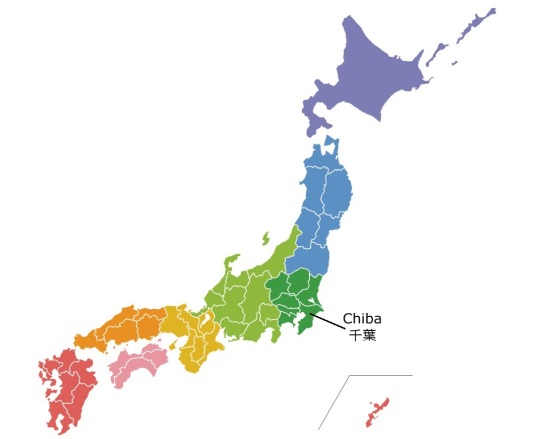
Chiba lies on the Bōsō Peninsula on the east coast of Tokyo Bay, about 20 miles (30 km) southeast of central Tokyo, and boasts many international facilities such as Narita International Airport, known as the gateway to Japan); Makuhari Messe, one of the most prominent convention centers in Asia; Kazusa DNA Research Institute, a world leader in cutting edge research; and Tokyo Disney Resort, with two theme parks that draw in 30 million patrons each year. It also boasts beaches for swimming, surfing, and diving and was the location for the first Olympic surfing games. Historically, Chiba was a castle town controlled by the Chiba family in the 12th–15th century, and during the Edo (Tokugawa) period (1603–1867) it served as a post-station town for several major roads. After the construction of a railway connecting it to Tokyo, the town began to grow in the second half of the 19th century.
Recommended Tourist Spot・おすすめ観光スポット Mt Nokogiri - 鋸山

Mt. Nokogiri - Hyaku-Shaku Kannon carved into stone cliff
Mt. Nokogiri is named for the zigzag shape of a traditional handsaw that its topography resembles. Along with Mt. Kanozan and Mt. Kiyosumi, Mt. Nokogiri is one of Chiba's three most famous mountains. It stands at 330 meters high and features a grand lookout point as well as a temple complex containing one of Japan's largest Buddhas. The mountain is bare granite and has been a quarry since the Edo Period, providing stones for many of Tokyo's most iconic sites, such as Yasukuni Shrine and Waseda University. You can reach the top by an easy hike or via a ropeway to the top. Hell Lookout (地獄のぞき) is a lookout point at the top of the mountain that hangs over the edge of the cliff and offers a stunning view of Tokyo Bay, the Pacific Ocean, and the distant forests and hills of the Boso Peninsula, and on clear days, Mt. Fuji.
At the southern base of Mt. Nokogiri is Nihonji Temple (日本寺), an officially designated Important Cultural Property. There's a stairway leading from the top of the mountain down to the vast, picturesque Soto Zen Buddhist temple that dates back 1300 years and is still used to train young monks today. A giant daibutsu, or Buddha statue, is carved into the granite on the side of Mt. Nokogiri about midway up the mountain. It is 31 meters high and one of Japan's largest Buddhas, even larger than Kamakura's famous daibutsu at Kotokuin Temple. The statue was built to pray for world peace and most of the statue was carved over three years beginning in 1780.
In addition to the giant daibutsu, there are around 1500 small statues of various Buddhist deities around the temple grounds. Unfortunately, many of the smaller statues were beheaded during the anti-Buddhist movement that accompanied the Meiji Restoration, but there are ongoing efforts to repair them. This part of Nihonji was a spiritual sanctuary built over 21 years in the 18th century by craftsman Ono Kangoro and his students. Towards the top of the mountain stands a 30-meter tall Hyaku-Shaku Kannon, depicting the Buddhist Goddess of Mercy. Carved in 1966 into a stone cliff, it is dedicated to those who died in wars, of sickness or in accidents. The Kannon is also worshiped as a protector of transportation due to its protected location surrounded by rocks.
Regional Cuisine - 郷土料理
Sangayaki - さんが焼き
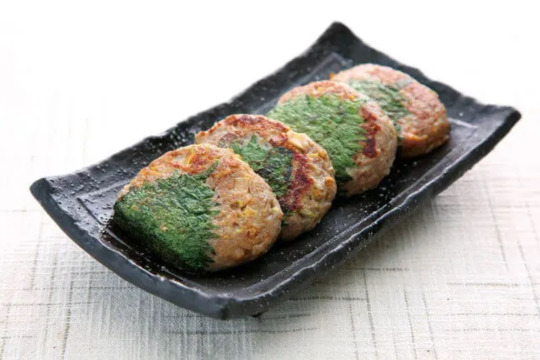
Sangayaki (source)
Namerou and sangayaki are well-known Chiba dishes, especially along the Bōsō Peninsula. Namerou (なめろう) is a dish usually made of minced horse mackerel and sardine mixed with miso, perilla leaves, and leek. When grilled and wrapped in perilla leaves, it is called sangayaki (さんが焼き). The name "namerou" may have come from the fact that namerou is so good that you want to lick your plate clean (nameru means to lick). The name "sangayaki" may be from the fact that the fishermen ate the dish along a river tributary, or sanga, and the word yaki means to grill (like yakisoba or yakitori). Namerou can be cooked in other ways, such as being shaped and grilled like a burger, or being coated in breadcrumbs and fried.
Chiba Dialect・Chiba no hougen・千葉の方言
Note: Chiba dialect is sometimes called Bōsō-ben (房総弁), after the peninsula. Chiba dialect is actually a family of three dialects: Bōshū-ben (房州弁), Tōsō-ben 東総弁, and Noda-ben (野田弁).
Bōshū-ben (房州弁)
1. おいねえ oinee not good
はしけえでおいねえや (hashikee de oinee ya)
Standard Japanese: かゆくていけないよ (kayukute ikenai yo)
English: This itches so badly
2. くわっせえ kuwassee please eat (command)
ばーさんほら、わーかでいーがらくわっせぇよ (baa-san hora, wa-ka de iigara kuwassei yo)
Standard Japanese: おばあさんほら、少しでいいから召し上がってよ (obaasan hora, sukoshi demo ii kara meshi agate yo)
English: Grandma, come on, please just eat a little bit
3. やんべえ yanbee health; condition (often used in a greeting)
いいやんべえだねえ (ii yanbee da nee)
Standard Japanese: こんにちは (konnichiwa)
English: Hello; Good day (lit. "you are in good health today")
Tōsō-ben 東総弁
1. あじょうだぁ ajyou daa how is it
あじょうだぁ? (ajyou daa?)
Standard Japanese: どうですか? (dou desu ka?)
English: How is it?
2. ねっけぇ nekkee warm
今日はずいぶんとねっけぇね (kyou wa zuibun to nekkee ne)
Standard Japanese: 今日はずいぶんと暖かいね (kyou wa zuibun to atatakai ne)
English: Today is fairly warm, isn't it?
3. わんらー wanraa you (informal, not very polite)
わんらーよー!んなことやってねーよ! (wanraa you! 'n na koto yatte nee yo!)
Standard Japanese: あなたねえ!そんな事しないでよ! (anata nee! sonna koto shinai de yo!)
English: Hey you! Stop doing that!
Noda-ben (野田弁)
1. こわい kowai difficult, taxing, bothersome
風邪ひいででまーだこわいだよなぁ (kaze hiide de maa-da kowai da yo naa)
Standard Japanese: 風邪を引いていてまだ身体がだるいんだよね (kaze wo hiite ite mada karada ga daruin da yo ne)
English: I have a cold and my body still feels listless
2. はらくち harakuchi full
はらくちだよなぁ (harakuchi da yo naa)
Standard Japanese: お腹いっぱいだよね (onaka ippai da yo ne)
English: I'm full
3. やっこら yakora soon
やっこらいくべ (yakora iku be)
Standard Japanese: そろそろいこうか (sorosoro ikou ka)
English: Shall we go soon?
33 notes
·
View notes
Photo

Koki Tsujimoto — Auspicious Blue & White Whale (mineral pigments on japanese paper mounted on wood panel, 2021)
5K notes
·
View notes
Text
A little reminder(s) on second language/ foreign language learnering
Even native speakers make typos.
Even native speakers say the wrong word.
Even native speakers sometimes forget how to spell/write a word/character.
Studying for a test is not the same as learning to communicate.
Scores don’t mean anything other than your retention of a specific set of information and should be used as a progress tracker not and end mark.
Though I’m all for testing and such, it���s important but it’s not the be-all end-all to mark how well you know something, and a lot of it is geared to a specific set of learners who have a very specific learning style.
If you say something and the other person understands you–or they say something and you understand them.. congratulations you spoke in a different language.
6K notes
·
View notes
Text
Japanese Phrases for Restaurants
Restaurants in Japan can be intimidating if you are unsure of your Japanese ability or how to navigate them. Here are some easy phrases to help you navigate common situations. (For more restaurant vocabulary & phrases, check my post HERE).

1. すみません sumimasen Excuse me
Usually wait staff will greet you at the entrance and guide you to a table, but if no one is there, you don't have to stand and wait forever. Using sumimasen will help to get their attention politely.
You can also use this to get the wait staff's attention. Raising your hand and calling out sumimasen will let them know you'd like them to come over.
If you don't understand something they are saying, you can also use this phrase as a question: sumimasen? They will repeat what they said or try to communicate it differently for you.
2. 二人です ふたりです futari desu For two
This phrase tells the staff that you have two people in your party. Usually they will ask you before seating you (何名様ですか? nan mei sama desu ka?) and you can use your fingers to indicate, or say one of the following:
一人です ひとりです hitori desu one person
二人です ふたりです futari desu two people
三人です さんにんです san nin desu three people
四人です よんにんです yon nin desu four people
3. おすすめは何ですか? おすすめはなんですか? osusume wa nan desu ka? What do you recommend?
Use this to get suggestions from the staff, especially if you are overwhelmed by the menu.
4. これは何ですか? これはなんですか? kore wa nan desu ka? What is this?
If you don't know what something is, ask! It beats trying to figure it out on your own as you get hungrier and hungrier.
5. これ、お願いします これ、おねがいします kore, onegai shimasu This one, please
Use this to point to something you would like, such as a photo or sample. You can also use これください (kore kudasai) which has the same meaning.
6. ベジタリアンメニューはありますか? Bejitarian menyu wa arimasu ka? Do you have a vegetarian menu?
You can use ~はありますか? (~ wa arimasu ka) to ask for various things.
7. たまごぬき、できますか? tamago nuki, dekimasu ka? Can you make it without egg?
If you have food restrictions, you can ask for menu items without certain ingredients by using ~ぬき、できますか? (~ nuki, dekimasu ka?). In my experience, often smaller restaurants won't let you change the ingredients, but you can always ask. If they can't make it without something, you can ask if they have a menu item without the ingredient by using ~ぬきのメニューはありますか? (~ nuki no menyu wa arimasu ka?) or "Do you have anything without ~?"
If you'd like to explain that you can't eat a particular ingredient, you can say ~が食べれません (~ ga taberemasen) which means "I can't eat ~."
If you have an allergy, be careful when ordering in a restaurant that serves food with your allergen. In Japanese, food allergy is 食物アレルギー (shokumotsu arerugii).
8. 持ち帰りにできますか? もちかえりにできますか? mochi kaeri ni dekimasu ka? Can I get this to go?
In most Japanese restaurants, they will not do to-go after you have started eating the meal for hygiene reasons, but you can always try asking.
9. 別々にできますか? べつべつにできますか? betsu betsu ni dekimasu ka? Can we pay separately?
Most izakaya (pubs) won't allow you to pay separately, but you can always ask.
10. ごちそうさまでした gochisou sama deshita Thank you for the meal
This phrase is used after eating in Japan, and if you use it as you leave the restaurant, you will let them know you enjoyed your meal.
527 notes
·
View notes
Text
JLPT Grammar げ・がち・っぽい・気味
What is the difference in usage among げ、がち、っぽい、and 気味? These grammar points can be difficult to differentiate, so I have gathered some notes and examples here. These grammar points are JLPT N3/N2 grammar points.
★~げ★
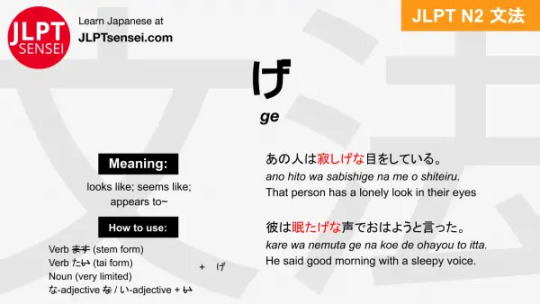
This is used it to describe something or someone (not yourself) who looks~ / seems~ / appears to~.
It is similar to そうに・そうな (sou ni / sou na), but げ (ge) is much more restricted with what words it can be paired with.
It is usually used to describe things like one’s emotions or state of being, whereas そう (sou) can be used with more general things like weather, etc.
Although this grammar is mostly used with adjectives, it can also be used with some verbs and nouns.
何か、言いたげだね。
They look like they want to say something.
ずいぶん、自信ありげだね。
You seem very confident.
そりゃあちょっとあやしげに見えますからね、そう思いませんか?
Well, that looks a little suspicious, don't you think?
同級生にテストの結果を聞くと、嬉しげな顔で100点だったと答えてくれた。
When I asked my classmate how they did on the test, they answered with a happy face that they got a perfect score.
★~がち★
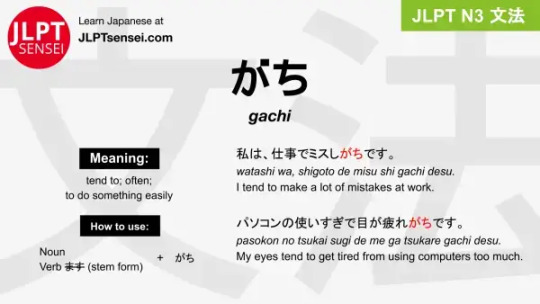
This is usually used for something negative.
ありがち = tend to have
になりがち = tend to become ~
遅れがち = tend to be late
留守がち = tend to be absent
彼は、学校をサボりがちです。
He is always skipping school.
ずっと曇りがちの天気が続いている。
The constant cloudy weather keeps continuing.
一人暮らしなので、コンビニ弁当ばかり食べがちだ。
I live alone, so I tend to only eat convenience store meals.
私は空腹の時は機嫌が悪くなりがちだ。
When I am hungry I easily get into a bad mood.
★~っぽい★

① When following a noun or い-adjective, this means -ish, -like, -ly. Note: The number of adjectives that can be used with this are limited.
子供っぽい = childish, childlike
男っぽい = manly, like a man
女っぽい = womanly, like a woman
油っぽい = oily, lots of oil
② When following a verb, this means easy to do, or often do~. Note: This cannot be used with all verbs.
忘れっぽい = easy to forget, often forget
怒りっぽい = easy to anger, often angry
このコート、デザインはいいけれど、生地が安っぽいね。
This coat has a nice design, but the material looks cheap.
油っぽい食事は好きじゃない。
I don't like oily foods.
年を取ると、忘れっぽくなる。
As you get older, you become more forgetful.
君は飽きっぽいから何事も成功しないのだ。
You do not succeed in anything because you are quick to lose interest.
★~気味 (ぎみ)★
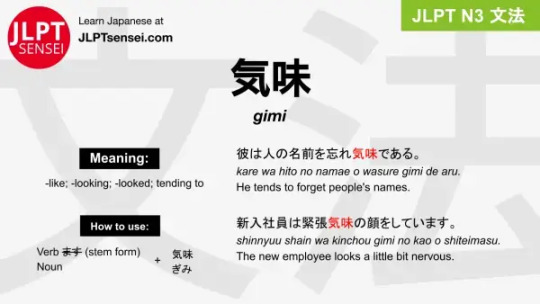
This is used to express that something looks or seems to be a certain way.
疲れ気味 【つかれぎみ】= looks / seems tired.
太り気味 【ふとりぎみ】 = looks / seems large
遅れ気味 【おくれぎみ】= tends to be late
寝不足気味 【ねぶそくぎみ】= looks / seems to be sleep deprived
残業続きで疲れ気味だ。
I've been feeling rather tired because of continuous overtime work.
新入社員は緊張気味の顔をしていた。
The new employee looked nervous.
彼は人の名前を忘れ気味である。
He tends to forget people's names.
彼女は遠慮気味にそう言った。
She said that hesitantly.
105 notes
·
View notes
Text
Podcast Review: Let's Talk in Japanese

Podcast Title: Let's Talk in Japanese!
Ease of Listening: ★★★★★
Length of Episodes: ★★★★★
Level of Engagement: ★★★★★
Episode Frequency: ★★★★★
Overall: ★★★★★
Today I will be reviewing the Let's Talk in Japanese! podcast by Tomo-sensei. This podcast is aimed at Japanese learners who want more chances to listen to spoken Japanese but using vocabulary and grammar that they can understand. The podcast is for levels N1 (the highest level) to N5 (the lowest level), but I would say that a majority of the content is focused on level N3 or N4.
Do I currently listen to this podcast?: Yes, I like this podcast a lot and listen to it frequently.
General Overview
Good For Levels: Beginner | Intermediate | Advanced
In this series, Tomo, a Japanese teacher for foreign students, discusses in Japanese only a variety of topics either selected by him or suggested by the audience. These can range from topics about daily life to JLPT related topics. He understandably discusses topics that he has a decent knowledge of, and admits when there are gaps. He is quite faithful to the level of each episode, which he indicates at the end of the episode title, so you can be sure that you will be able to understand the majority of the content or challenge yourself as the case may be.
Length of Episodes ★★★★★
The podcasts are usually around 10-15 minutes long. This is ideal for a quick listen when you are short on time or just want to supplement your studies, but may not be ideal if you are looking for something a bit longer. I usually listen to two or three podcasts in a row during my commute and feel like I've spent my time well. The short length can be useful if you are not interested in a particular topic, because you can make it to the end of the episode without losing interest and a new topic will come up with the next episode.
Level of Engagement ★★★★★
Although this is just one person (Tomo) talking throughout the podcast, he is engaging because he speaks as though he is talking to a small group. I find it engaging because I can, in the privacy of my room or car, reply to him when he poses questions, or make a response if I am surprised by what he says, etc. Even though it's not interactive per se, it can feel interactive because of the way he speaks in his podcast. I find myself engaged in most episodes, and the shorter length means I don't have to work as hard to stay engaged through the entire episode.
Episode Frequency ★★★★★
New podcasts come out about weekly, and sometimes more frequently than that. I have heard that he works very hard to put out the podcasts so frequently, and I think this intense schedule plus the large archive of material means you can listen almost indefinitely to this podcast.
Overall ★★★★★
This podcast is completely in Japanese and designed by a Japanese teacher for foreigners learning Japanese, and has material for everyone from beginners to advanced learners. The shorter episodes mean you can fit it into a busy schedule, and the JLPT labels mean you can pick and choose episodes based on your own level and be confident that you will get what you expect. I highly recommend this for those looking to improve their listening skills.
147 notes
·
View notes
Text
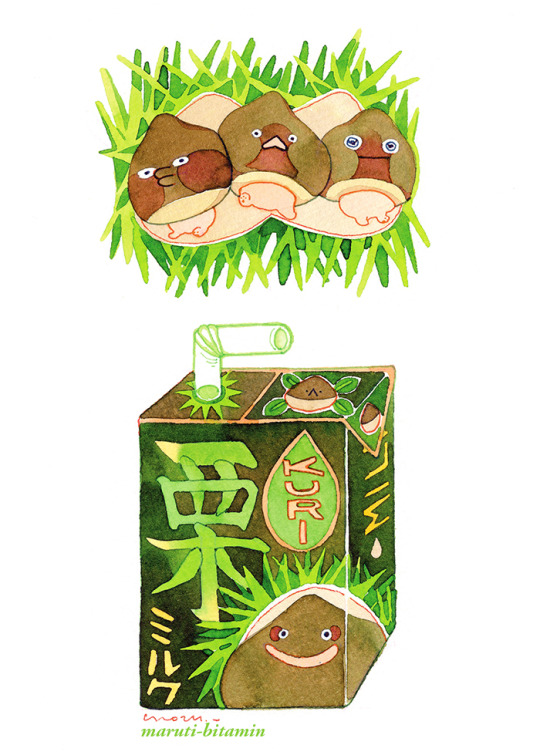
freshly squeezed
chestnut milk
There are so many kinds of nut milk.
Is there chestnut milk too?
I think it would be yummy.
twitter/ insta/ store
2K notes
·
View notes
Text
水彩画
すいさいが
watercolor painting
それから休日には植物園などへ、水彩画の写生に出かけしものなり。
それから きゅうじつ に は しょくぶつえん など へ、すいさいが の しゃせい に でかけしもの なり。
Then, on my days off, I would go to botanical gardens and sketch watercolors.

43 notes
·
View notes
Text
薄着
うすぎ
= be lightly dressed. ⇔厚着
Ex. そんなに薄着で寒くないですか。
そんなに うすぎで さむくないですか。
Are you warm enough in such thin clothes?

16 notes
·
View notes
Photo

I went out for the first time in my life.👜🐌✨
I saw lavender in bloom.👀
This flower smells good.❤️
うまれて初めてお出かけしたよ👜🐌✨
ラベンダーが咲いているのを見ました👀
この花はいい匂いがする❤️
3K notes
·
View notes
Text

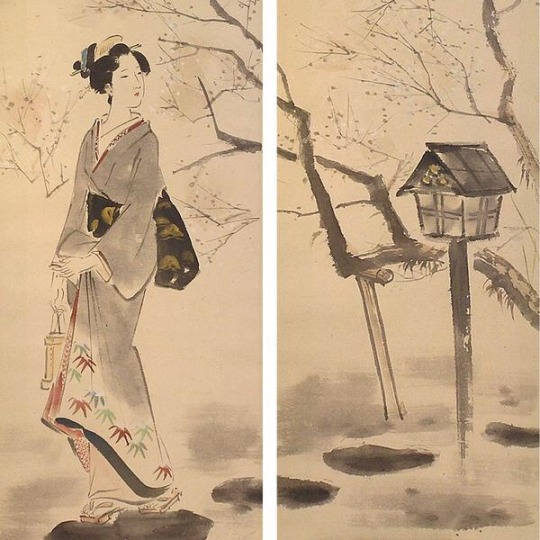
Kobayakawa Kyoshi (1897-1948) — Bijin in a Plum Garden (details)
799 notes
·
View notes

